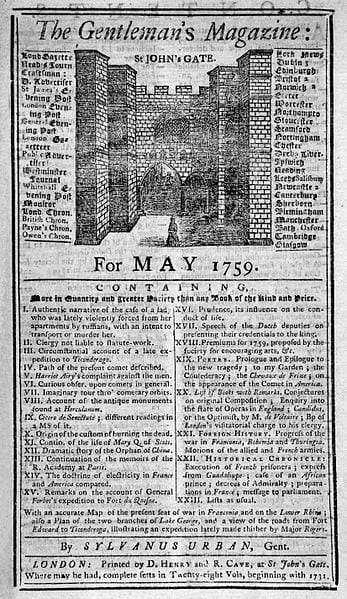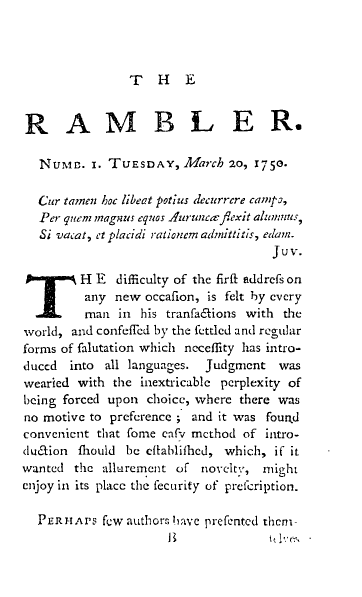~The Longman Anthology of British Literature
This page displays a few descriptions of journalists and the periodicals they created during the time of the Restoration and 18th century London.
 |
| Richard Steele |
Authors
Richard Steele- (1672-1729) An author who wanted to teach and impress his readers, Steele was the London Gazette editor and author of The Tatler. His writings made sure to include the reader into it’s articles and essays, and “For the rest of the century [Steele’s] first task was to devise a persona unusual enough to define [his] paper, and engaging enough to sustain it” (Damrosch 2462).
Benjamin Harris– (-1720) An English writer who was jailed for accusations concerning “violating the printing and bookselling laws of King Charles II” (Brown). The works in question were his A Protestant Petition or his London Post. “Harris’ most
| Eliza Haywood |
su ccessful venture into the book publishing field” was his The New-England Primer in 1687-16 90 (Brown).
Eliza Haywood- (1693-1756) A romantic novelists who wrote “sensational romantic novels that mirrored contemporary 18th-century scandals” (Haywood). The author of The Spectator, “each number presented an essay focused on a single topic with several illustrative fictional stories interspersed” (Damrosch 2468). “The Female Spectator continued to sell, in a four-volume collected edition, for more than two decades after its periodical run had ceased” (Damrosch 2468). Other works of Haywood include The Female Dunciad, 1729, and The History of Jemmy and Jenny Jessamy, 1753 (Haywood).
Periodicals
The London Gazette- Originally titled the Oxford Gazette and is perceived as the first real newspaper in England that was published in 1665 by the government. The Gazette was “a complete innovation, replacing the traditional format of the news-book with a half sheet folio: a two-page newspaper, set for the first time in double columns, and…for the rest of the seventeenth century this was to be the normal format for an English newspaper” (Sutherland 11).
The Tatler- A periodical that was in publication from 1709-1711 and was co-authored by Sir Richard Steele and his colleague Joseph Addison. The paper began as one separated into four sections of news but then gradually included a more essay-type style. It’s stated purpose was to inform readers of political news and to provide entertainment. “It contains news-reporting and partisan essays, championing Whig values; moral crusades, in particular against dueling and gambling; essays on contemporary manners and morals; Oriental tales; short stories; allegorical dream-visions; and readers letters” (The Tatler).
 |
| The Spectator |
 |
| The Gentleman’s Magazine |
The Spectator- (1711-1713) Another periodical in which Richard Steele and Joseph Addison worked together. This was the first attempt for the two writers to publish the paper everyday for their readers. Also in this paper was the new persona they created in “Mr. Spectator” who “managed to embody and to allegorize the operations of the paper he inhabited” (Damrosch 2465).
The Gentleman’s Magazine- a pamphlet produced monthly created by Edward Cave from 1731-1868. Although it contained a variety of information like the newspaper, it represented a new form of presenting news as a magazine. The writings in this magazine consisted of works from several books and other pamphlets combined, with “an ever-widening range of fresh materials: biographies, poetry, parliamentary debates” (Damrosch 2475). Samuel Johnson was among those authors who contributed their work to the magazine.
The Female Spectator- Eliza Haywood contributed to the first female newspaper titled The Female Spe
 |
| The Rambler |
ctator which from 1744-1746 was a pamphlet periodical that circulated monthly for its readers.
The Rambler- (1750-1752) A John Payne periodical with a majority of it’s essays written by Samuel Johnson. Payne’s objective was to teach his readers, and the writing dealt with how to “deal with the disappointments inherent in life and with the setbacks to ambition” (Rambler).
Return to The Newspaper and Periodicals page
Works Cited:
Brown, Lea Ann. “Benjamin Harris.” Dictionary of Literary Biography. vol 43:1985. 278-285. 19 Apr. 2008.
Damrosch, David, and Kevin J.H. Dettmar. The Longman Anthology of British Literature. 3rd ed. United States: Pearson Education, Inc., 2006.
“Haywood, Eliza.” Encyclopedia Britannica. 2008. Encyclopedia Britannica Online. 14 May 2008
http://www.britannica.com/eb/article-9039678
“Haywood, Eliza.” Online Photograph. Encyclopedia Britannica Online. 15 May 2008
http://www.britannica.com/eb/art-11483
Iona, Italia, University of Anglia. “The Tatler.” The Literary Encyclopedia. 4 Nov. 2004. Accessed 13 Apr. 2008
http://www.litencyc.com/php/sworks.php?rec=true&UID=7889
“Rambler, The.” Encyclopedia Britannica. 2008. Encyclopedia Britannica Online. 14 May 2008
http://www.britannica.com/eb/article-9062584
Richard Steele image found through Creative Commons from:http://www.gutenberg.org/files/12030/12030-h/12030-h/SV3/transindex.html
Sutherland, James. The Restoration Newspaper and its Development. Great Britain: Cambridge University Press, 1986.
The Gentleman’s Magazine image found through Creative Commons from: http://upload.wikimedia.org/wikipedia/commons/thumb/6/6e/The_Gentleman’s_Magazine,_May_1759.jpg/347px-
The_Gentleman’s_Magazine,_May_1759.jpg
Contributor:
Lindsay Milbourne
